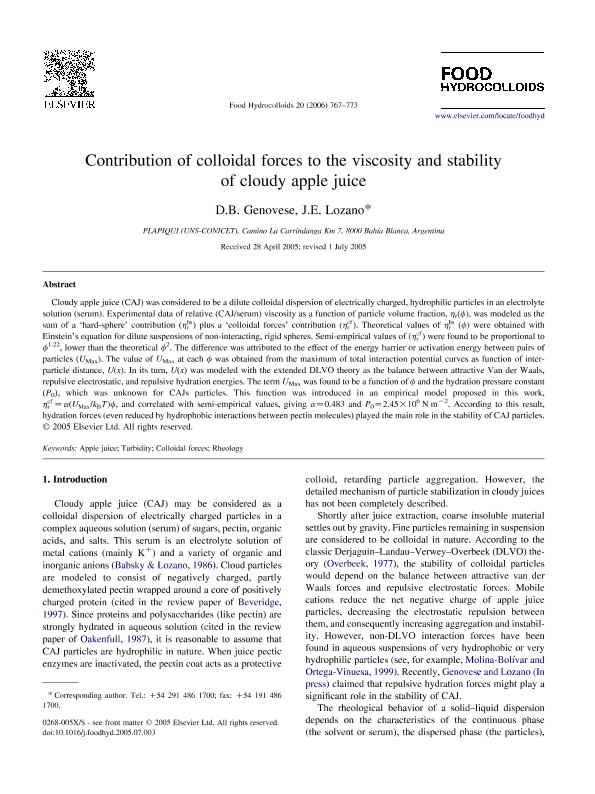Artículo
Contribution of colloidal forces to the viscosity and stability of cloudy apple juice
Fecha de publicación:
08/2006
Editorial:
Elsevier
Revista:
Food Hydrocolloids
ISSN:
0268-005X
Idioma:
Inglés
Tipo de recurso:
Artículo publicado
Clasificación temática:
Resumen
Cloudy apple juice (CAJ) was considered to be a dilute colloidal dispersion of electrically charged, hydrophilic particles in an electrolyte solution (serum). Experimental data of relative (CAJ/serum) viscosity as a function of particle volume fraction, ηr(φ{symbol}), was modeled as the sum of a 'hard-sphere' contribution ( ηr hs ) plus a 'colloidal forces' contribution ( ηr cf ). Theoretical values of ηr hs (φ{symbol}) were obtained with Einstein's equation for dilute suspensions of non-interacting, rigid spheres. Semi-empirical values of ( ηr cf ) were found to be proportional to φ{symbol}1.22, lower than the theoretical φ{symbol}2. The difference was attributed to the effect of the energy barrier or activation energy between pairs of particles (UMax). The value of UMax at each φ{symbol} was obtained from the maximum of total interaction potential curves as function of inter-particle distance, U(x). In its turn, U(x) was modeled with the extended DLVO theory as the balance between attractive Van der Waals, repulsive electrostatic, and repulsive hydration energies. The term UMax was found to be a function of φ{symbol} and the hydration pressure constant (P0), which was unknown for CAJs particles. This function was introduced in an empirical model proposed in this work, ηr cf = α ( UMax / kB T ) φ{symbol}, and correlated with semi-empirical values, giving α=0.483 and P0=2.45×106 N m-2. According to this result, hydration forces (even reduced by hydrophobic interactions between pectin molecules) played the main role in the stability of CAJ particles.
Palabras clave:
Apple Juice
,
Colloidal Forces
,
Rheology
,
Turbidity
Archivos asociados
Licencia
Identificadores
Colecciones
Articulos(PLAPIQUI)
Articulos de PLANTA PILOTO DE INGENIERIA QUIMICA (I)
Articulos de PLANTA PILOTO DE INGENIERIA QUIMICA (I)
Citación
Genovese, Diego Bautista; Lozano, Jorge Enrique; Contribution of colloidal forces to the viscosity and stability of cloudy apple juice; Elsevier; Food Hydrocolloids; 20; 6; 8-2006; 767-773
Compartir
Altmétricas




